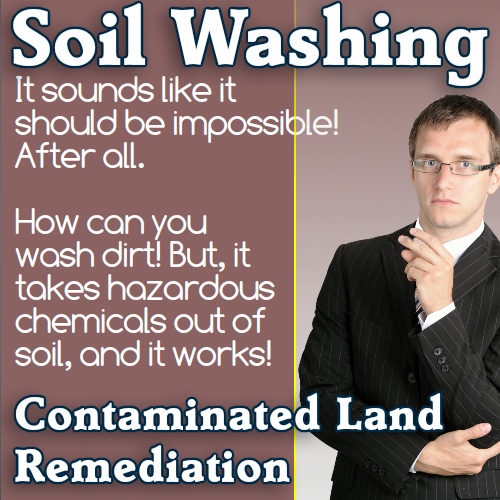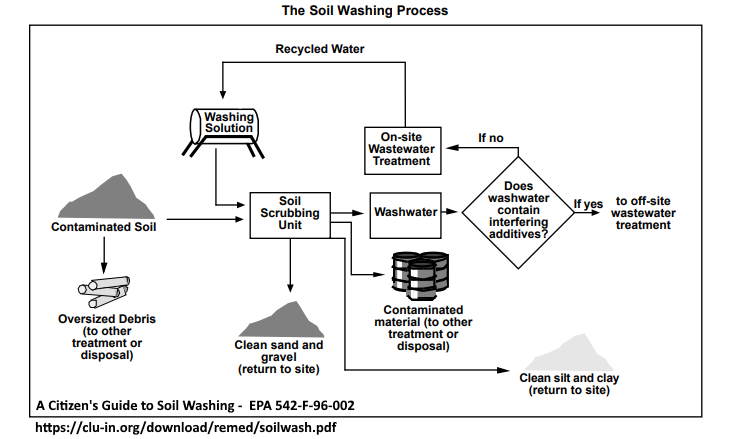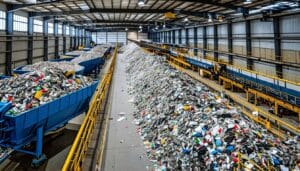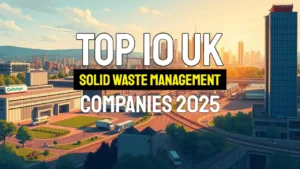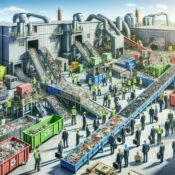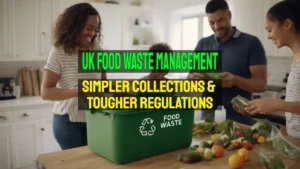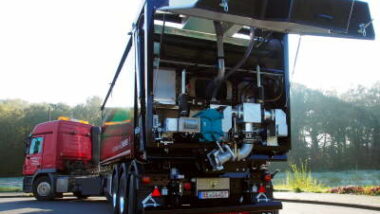Soil washing has become an important method for cleaning up contaminated land. It was first propelled into the mainstream as a process for this purpose in the UK in 2004. The reason for this was that the summer of 2004 saw the implementation of EU Landfill Directive requirements in the UK. The implementation of EU legislation slashed the available number of UK landfill sites available for all forms of waste disposal and especially for contaminated wastes. For the first time, the disposal of soils from contaminated land to non-hazardous landfills was banned.
The cost for disposal of contaminated soils to landfill rose massively as a consequence, and suddenly it made sense economically to carry out in-situ methods to clean up soils, with methods like soil washing, rather than transport them to the much more expensive landfills. The article which follows:
On This Page
- Soil Washing Adoption in the US
- Solvent Extraction and Soil Washing Treatment of Contaminated Soils from Wood Preserving Sites
- Soil Washing Removes Heavy Metals from Contaminated Soil
- Soil Washing Plants for Contaminated Soil
- Arsenic Soil Remediation using Soil Washing at Vineland Chemical Superfund Site
- Design and Fabrication of a Mobile Soil Washing Plant
- Treatment of Contaminated Land by Soil Washing
- Why Treating Contaminated Land Will Be Different Each Time
- Contaminated Land and Soil Remediation
- When is contaminated land a problem?
- Soil Washing Land Treatment Technologies in the UK
- Phase 1 Contaminated Land Survey – Desk Study
- Why do I need a Contaminated Land Survey?
- Request an Asbestos Contaminated Land & Soil Test
Soil Washing Adoption in the US
Between 1984 and 2008, soil washing was chosen as the remediation technique in 1% (or 6 projects) of us EPA superfund projects (US EPA 2010). Therefore, it is not as commonly chosen as other remedy techniques such as bioremediation or soil vapour extraction, but given certain site conditions that allow for soil washing, it can be an effective technique (US EPA 2010).
 Contaminated land remediation is a widespread and costly problem, and the traditional excavation-and-disposal treatment method is not a sustainable solution. Chelating agents (organic compounds that can bind metal ions) are an attractive new technology for land decontamination because chelating agents enhance metal extraction from contaminated soil or sediment and facilitate metal mobility in subsurface soils.
Contaminated land remediation is a widespread and costly problem, and the traditional excavation-and-disposal treatment method is not a sustainable solution. Chelating agents (organic compounds that can bind metal ions) are an attractive new technology for land decontamination because chelating agents enhance metal extraction from contaminated soil or sediment and facilitate metal mobility in subsurface soils.
Solvent extraction and soil washing treatment of contaminated soils from wood preserving sites
Bench‐scale solvent extraction and soil washing studies were performed on soil samples obtained from three abandoned wood preserving sites included in the US National Priority List. The soil samples from these sites were contaminated with high levels of polyaromatic hydrocarbons (PAHS), pentachlorophenol (PCP), dioxins, and heavy metals. The effectiveness of the solvent extraction process was assessed using liquefied propane or dimethyl ether as solvents over a range of operating conditions. These studies have demonstrated that a two‐stage solvent extraction process using dimethyl ether as a solvent at a ratio of 1. 61 per kg of soil could decrease dioxin levels in the soil by 93. 0% to 98. 9%, and PCP levels by 95. 1%. Reduction percentages for benzo(a)pyrene (bap) potency estimate and total detected pahs were 82. 4 and 98. 6%, respectively. Metals concentrations were not reduced by solvent extraction treatment. These removal levels could be significantly improved using a multistage extraction system. Commercial-scale solvent extraction using liquefied gases costs about $220 per ton of contaminated soil. However, field application of this technology was found impracticable due to excessive foaming and air emission problems.
Soil Washing Removes Heavy Metals from Contaminated Soil
Previous studies (bench and pilot scale) conducted on various soil, sediment and sludge samples have consistently shown that the GHEA soil washing process can achieve exceptional cleanup efficiencies on various contaminants including PCBs, pah's; chlorinated solvents and heavy metals (e. g. Cleanup efficiencies in excess of 99. 9% for soils typically containing fine silts and clays in the 25-50% range). Application of the GHEA process to handle soils and sediments which are contaminated by mixtures of hazardous organics/inorganics can meet.
Soil washing has been shown to be able to remediated/reduce the volume of contaminated soil, contaminated with diesel range organics (DRO), semi-volatile organic compounds (SVOCs)
heavy metals (lead, chromium etc), and pesticides.
With the increasing population and demand for agricultural land, soil contamination is becoming a serious global environmental crisis. Heavy metals in soil resulting from anthropogenic activities are one of the most critical issues, particularly given a large number of widespread poisoning incidents. Considering the high accumulation rate of heavy metals in the earth’s upper crust due to the jumping global mining production and industrial demand, the economical and efficient remediation of contaminated urban and agricultural land is in pressing need for a sustainable development prospect.
In general cases, heavy metals in soil are in the form of cations and retained on soil particles by electrostatic attraction or forming chemical bonds with organic or inorganic ligand ions. One remediation solution is soil washing with a strong chelating agent which liberates heavy metal cations from the functional groups on the surface of soil particles.
However, there are three concerns hindering the application of this technology:
- the high consumption of chelating agents
- the lack of efficient strategy to treat the washing effluent, and
- the excessive soil nutrient loss after washing.
SOIL WASHING PLANTS FOR CONTAMINATED SOIL
The Baioni environment division, designs, manufactures, and erects soil washing plants for the remediation of soils contaminated by different types of contaminants including:
- heavy metals,
- hydrocarbons,
- pesticides, etc.

Soil washing installations are made for the treatment of contaminated soils in order to recover the valuable part which is identified as the alternative resource to reduce the need for new quarries and landfills. Soil washing plants for excavated soil as each plant is made to measure according to the characterization of soil to be reclaimed, and with the intent to give customers the best technical and economic solution, Baioni designs soil washing plants on data provided by laboratory tests that our partner companies carry out on significant samples of soil. These projects require an intense degree of design care and an integrated approach, combining civil engineering, hydrogeology and environmental technology.
Soils contaminated with Pb, Zn and Cd are hazardous. Persistent EDTA and biodegradable GLDA, EDDS and IDS have all been used as chelators in the soil washing technology, which recycles chelator and curbs toxic emissions. The washed soils supported similar growth of buckwheat (f. Esculentum) and better growth of Chinese Cabbage (B. Rapa) compared with the original (not-remediated) soil. The growth of buckwheat on EDDS-washed soil was an exception and was 67% suppressed. The activities of enzymes of the plant antioxidant preventive system were assessed in roots and leaves of Chinese Cabbage on all soils. Similar activities were measured, confirming that washed soils are not harmful to the plants. Plant uptake of potentially toxic elements was reduced from all washed soils, (i.e. Buckwheat when grown on GLDA-washed soils accumulated up to 27 and 83 times less Pb and Cd than in the original soil. The initial Pb emissions in leachate from GLDA and IDS washed soils were up to 89 and 92% higher than those of the original soil, respectively. The latter emissions ceased to the levels measured in original, EDTA and EDDS washed soils.
Arsenic Soil Remediation using Soil Washing at Vineland Chemical Superfund Site, Vineland, NJ
The U. S. Environmental Protection Agency (EPA) has decided to use a different and more efficient cleanup method to remove arsenic from 170,000 cubic yards of plant site soils at the vineland chemical co. Superfund site in Cumberland County, NJ. The new method will reduce remediation time by years, reports the agency. After careful testing and evaluation, EPA determined that the previously selected cleanup method, “soil flushing,” would take over 40 years to meet the agency's cleanup goal for the soil in the most contaminated locations. The newly selected method, “soil washing,” will reduce the arsenic levels to the cleanup goal in approximately two years.
Design and Fabrication of a Mobile Soil Washing Plant
Cost savings can be achieved through the use of mobile soil washing installations.
soil washing is an effective technique to remediate contaminated soil, removing a large number of organic and inorganic contaminants. DEC has designed, developed and built a number of mobile soil washing and recycling systems that can be employed worldwide for the on-site treatment and recycling of contaminated soil. These mobile installations avoid unnecessary soil transport and disposal costs for the client. DEC’s mobile soil washing plant incorporates the most up-to-date soil washing technologies and has a capacity of 30-45 tons/hr.
A project conducted at Hazen included recovery of lead, plastic, and ebonite from the soil at a CERCLA battery-processing site. Decontamination of high-clay soil, using a proprietary organic solvent. The concentration of soil radioactivity into the fines fraction. Removal of uranium from mixed waste. Removal of organic chemicals from steel plant waste. Construction and operation of a mobile soil-washing pilot plant. The concentration of petroleum hydrocarbons into fines feed for a slurry bioreactor. Removal of chromium and other rare metals from soil. Hazen's facilities include equipment designed for various soil remediation unit operations.
Treatment of Contaminated Land by Soil Washing
 Soil washing is a water-based process for scrubbing soils ex-situ to remove contaminants. Two mechanisms remove contaminants: particle size separation and dissolution into the wash water. As discussed previously, some metals and some organics have a tendency to bind to the clay and silt fraction in soils. A large proportion of the contaminants will be removed by simple particle separation and subsequent treatment or disposal. Contaminants can also be removed from the soil by adding different compounds, such as complexing agents, leaching agents, or surfactants to the wash water, or by adjusting the ph of the wash water. Treatment of the wash water will be required to remove the dissolved contaminants desorbed from the soil. A likely treatment technique for the wash water is granular activated carbon adsorption. Soil washing has been effective on petroleum-contaminated soils.
Soil washing is a water-based process for scrubbing soils ex-situ to remove contaminants. Two mechanisms remove contaminants: particle size separation and dissolution into the wash water. As discussed previously, some metals and some organics have a tendency to bind to the clay and silt fraction in soils. A large proportion of the contaminants will be removed by simple particle separation and subsequent treatment or disposal. Contaminants can also be removed from the soil by adding different compounds, such as complexing agents, leaching agents, or surfactants to the wash water, or by adjusting the ph of the wash water. Treatment of the wash water will be required to remove the dissolved contaminants desorbed from the soil. A likely treatment technique for the wash water is granular activated carbon adsorption. Soil washing has been effective on petroleum-contaminated soils.
The cleanup of unimproved land or water such as might occur at the site of an oil spill on an undeveloped beach receives specific tax treatment. Gross revenue from these types of clean-ups is subject to tax classification and a possible tax liability.
The activities may include the following:
- skimming oil off the water
- using absorbents to remove oil from land or water
- pumping oily water from a vessel and disposing of the wastewater
- cleaning contaminated fowl or mammals
- high-pressure washing of land
- cleaning contaminated soil.
The use of conventional, engineering-type techniques to clean up metal-contaminated soils is typically invasive and expensive. For example, in soil-washing, the soil has to be excavated first and usually treated off-site. The treated soil may be returned to the site or landfilled. The washing not only irreversibly destroys the integrity of the soil in a general sense, but also produces a secondary waste – the washing effluent, which is usually a chelate solution now laden with metals. The most logical, ecologically friendly and economically viable method is by in situ immobilization of metals using abundant, inexpensive soil amendments. This technique is particularly suitable for the treatment of big tracts of land where the soil is mostly superficially contaminated. Soil amendments that have been successfully tested in North America, Europe, and Australia include liming materials, rock phosphate (hydroxyapatite), alkaline biosolids and/or compost, Fe-rich by-products (steel shot, red mud, ‘Fe-rich’ from aluminium processing), and coal residues (alkaline coal fly ash, beringite).
Why Treating Contaminated Land Will Be Different Each Time
Soil contamination has been handled using the following alternatives, but all sites differ and there is most likely no simple common solution to the multiple options which are common:
• abandoning of contaminated soil and restricting the use of the contaminated site
• capping or encapsulating the soil in situ with water-resistant material and covering with a layer of clean topsoil
• excavating the contaminated soil and disposing of it at a hazardous waste landfill
• treating the contaminated soil using ex-situ methods.
Choice of Soil Remediation Approaches
Selection of soil /sediment remediation approaches is dependent on soil type, soil composition physical properties of soil, contaminant nature, the feasibility of contaminant isolation, handling intensity, cost etc. Sometimes it is possible for some biological and tinting methods to extremely alter the existing chemical properties of soil by addition of chemicals and nutrients to enhance the growth of soil microbes. On the other hand, land-use restrictions and in-situ soil flushing methods could sometimes be the cause of groundwater contamination. Thermal soil treatment methods destroy the soil’s organic and clay components causing oxidation of compounds yielding problematic products. Sandy and rocky soils can possibly be used as backfill; the clayey substrates with a high share of pelletized material are not appropriate for many types of construction stresses.
Contaminated Land and Soil Remediation
The need for soil remediation on contaminated land and has increased significantly due to increased knowledge around current and emerging contaminants as well as an ever-increasing demand for urban housing. Brownfield sites and metal-polluted hotspot areas are increasingly being used as locations for redevelopment opportunities. The risk of contaminants leaching into water sources can lead to direct contamination of human drinking sources or lead to bioaccumulation of chemicals in animals which can eventually make their way into the food chain. Therefore, removing pollutants and contaminants in the soil is vital to ensure safety for humans and wildlife.
BEI offers timely and experienced service for release remediation using a variety of approved methods, including; dig and haul, bioremediation land farming and air-sparging. Dig and haul is the excavation and removal of hydrocarbon-contaminated soils, and transported an approved disposal facility. The process includes backfilling, compaction, and hazardous waste treatment.
Production, transport, and application of pesticides and pesticide concentrate often result in soil contamination. Sorption to soil particulate matter and toxicity to microorganisms further result in the environmental persistence of these compounds; thus, the soils are not readily remediated by typical solid-phase biotreatment (e. g. land farming). No, currently existing bioremediation strategies are available that result in the destruction of these sorbed pesticides, even though many of them are known to be biodegradable. The purpose of this article is to share innovative remedial techniques, based on a combination of currently existing unit processes, elaborated specifically to address pesticide-contaminated soils. The techniques include several “soil washing” processes and slurry biotreatment. A sample of pesticide-contaminated soil from a distribution facility will be used for the study. The soil is contaminated with cyanazine, carbofuran, metolachlor, and trifluralin. The process will be evaluated based on relative removal rates and extents of the various compounds through each of the unit processes. The goal is to determine the potential of the overall process as a remedial technique for pesticides.
When is contaminated land a problem?
There is much benefit to be gained by forming alliances with other agencies, particularly members of the local enterprise company (LEC) network. A major obstacle to the development of contaminated, or potentially contaminated, sites is uncertainty as to the extent and nature of the contamination. Furthermore, such sites often have other problems e.g. Instability, and/ or fragmented/unknown ownership.
Planning authorities and other agencies can play a positive role in reducing uncertainty and promoting opportunity. Scottish enterprise Lanarkshire has developed a strong working relationship with North and South Lanarkshire councils to tackle the problem of derelict industrial land. They have targeted individual sites and clusters of sites to promote development. This has involved compiling information on sites, including site investigations, and producing and distributing fact sheets to potential developers. Putting information together in such a package assists prospective developers to ascertain relevant information and identify what further investigative work is required. This has proved successful in bringing land that has lain vacant and derelict for a considerable time into productive use.
Soil can be contaminated by many different human activities when hazardous substances are not used, stored or disposed of safely. Instances of soil contamination are highest in urban areas and former industrial sites, where manufacturing, industrial dumping, land development, waste disposal, and excessive pesticide or fertilizer use could potentially occur. Some contaminants, such as agricultural chemicals, are applied to the soil surface. Others are released below the surface, due to leaks from buried tanks, sewage pipes, or landfills. Atmospheric contaminants containing hazardous substances can also cause problems. Furthermore, contamination is not always limited to a specific site and can seep through the soil into groundwater or be carried to nearby land and waterways in rainwater, or as dust.
in the first and second contaminated land modules, we use the source – pathway – receptor philosophy to assist in addressing the investigation and assessment of contaminated land, and in this module, we shall again use it to help us consider the options for remediation. Historically in the UK and many other developed countries, the traditional approach to land remediation has been to dig up the contaminated material and deposit it in a landfill. In extreme cases, the contaminated soil has been incinerated. This is an effective way of removing the source of contamination at the site and, if carried out properly, can result in a site acceptable for redevelopment after the import of clean material to replace that which has been removed. Unfortunately, a great deal of valuable landfill space has been taken up by this type of activity, and it has become recognised as the mere transport of the problem elsewhere as opposed to sustainable remediation. Recent planning and waste management policies, not least of which is the introduction of the landfill tax in the UK, discourage the practice of transporting contaminated materials away from sites and promote the development of on-site remedial techniques, many of which have been available for several years – especially in the USA.
Soil Washing Land Treatment Technologies in the UK
In the summer of 2005, the UK rules for contaminated land soil disposal to landfill were tightened to comply with EU directives. The requirement that no wastes shall be sent to hazardous waste landfill in excess of 6% organic matter (carbon), was introduced and the new Waste Acceptance Criteria now require that all wastes sent to hazardous waste landfill shall have been pre-treated.
Prices for waste disposal to hazardous landfill rose dramatically, to above £100/tonne in 2018 in the UK, and are frequently in the region of £150/tonne and that, or higher is where they will now stay.
The result is that since that time, the contaminated land remediation industry has been, wherever possible, using alternative methods to landfill disposal to achieve the clean-up of contaminated land, and one of those methods is “Soil washing” in order to treat contaminated waste in-situ.
“Biopiling” is another option, where the contaminant is biological.
Soil Washing Requirements
Soil washing requires a reasonably permeable soil with a fines percentage normally below about 30%. Large material is screened out using a suitable mesh size.
As the name suggests the primary aim is to wash the granular fraction of the material through a water-wash solids scrubbing unit. Organic materials are removed, the clean larger particle sizes (gravels and sands) are washed, allowed to settle, separated and removed, Further sieving may be applied, and the result is that the washed clean sands and gravels are now non-hazardous and can be returned to the land.
The remaining silts and clay materials containing the contaminants are further treated, normally by coagulation and flocculation to achieve settlement in a lagoon, and the resulting sludge must then be dewatered to become a solid again.
Sludge presses, hydro cyclones and/or centrifuges are used for dewatering and a substantially reduced volume of sludge “cake” remains, for which there is normally no option but to send it to landfill, or possibly in some circumstances to solidify in concrete or incinerate.
Most of the water used is recycled, but some will require treatment and/or tankerage to suitable disposal at an industrial effluent treatment facility.
The Phase 1 Contaminated Land Survey – Desk Study
A Phase 1 Contamination Survey is a necessary first step in any contaminated land assessment, as it forms the basis for all further decisions made. The majority of sites surveyed by Adeptus present negligible risk to human health or the environment, and undertaking a desk study of environmental, geological and ordnance survey data, regulatory records and other information, can allow this to be demonstrated without incurring the cost of mobilising equipment to site, sampling and laboratory analysis.
A site walkover survey (site reconnaissance) may also be undertaken at this stage to allow visual inspection of the site and surrounding area. This allows the desk study information to be confirmed on-site, and assessment of related items such as structures, tanks, pipework, drains, ground cover, vegetation and any adjacent land uses.
Why do I need a Contaminated Land Survey?
Of 3,294 cadastral parcels where an exploratory soil survey was carried out between 2005 and 2012, 39% were found to be contaminated land remediation or risk management proposals were put forward for 13% of these. As a result, 398 hectares of land were made available for new purposes (such as housing and economic activity) through remediation or risk management.
Asbestos contaminated land surveys for asbestos in soils and identification of asbestos-contaminated land remediation. Land contaminated with asbestos is becoming more of an issue when developing brownfield sites and with an emphasis on building more homes in the UK. This area of asbestos risk management will continue to grow with developers often requiring the analytical and consultancy support of a partner. We work with clients and their advisers from the outset of a project to formulate an effective and practical strategy for investigating and remediating sites that could potentially be contaminated with asbestos.
Request an Asbestos Contaminated Land & Soil Test
If you suspect your construction site is contaminated a fast-tracked soil sample testing kit can be ordered which enables testing for asbestos or other soil contamination. If your site is contaminated we can assist with specialist contaminated soil removal, remediation and disposal services. The common thought process when dealing with soils which have been contaminated with asbestos or other contaminant is generally to dispose of the material to a landfill site as hazardous waste. Asbestos soil remediation is prominently addressed by excavation and disposal, which is expensive and normally attracts hazardous disposal charges at the higher rate of landfill tax.
Asbestos land remediation can be very complex. We have extensive experience in all types of asbestos remediation and cleaning of soil/material contaminated with asbestos. This ranges from non-licensed products such as asbestos cement all the way through to licensed materials such as asbestos insulation and asbestos boarding. Removing asbestos from the soil is a lengthy and difficult process. The bigger the site the more complicated the remediation can be. The first type of remediation to be considered id the physical removal of asbestos material fragments from the soil. This is known as “picking”. This is a tried and tested method prior to soil going for reuse or to landfill. However, if the asbestos contamination is not in a solid-state then this method cannot be utilised. Where loose fibre is present throughout sometimes the only way to remediate the site is for the soil to be disposed of as asbestos-contaminated waste. “asbestos waste is ‘hazardous waste’ when it contains more than 0. 1% asbestos content”. The only way to confirm this percentage is to undertake WAC testing of the soil.
Page first published in 2014, and extensively updated July 2020.
Revolutionizing Waste Recovery: Latest Separation And Sorting Innovations
Waste recovery is changing fast, thanks to new separation and sorting technology. This tech helps us sort trash better, so we can recycle more things. For example, Stadler has built a big plant in Spain for VAERSA that makes recycling easier and smarter. Keson is finding new ways to deal with old tyres, helping both […]
Top 10 UK Solid Waste Management Companies 2025
The UK waste management sector stands as a vital industry worth billions of pounds. The top UK Solid Waste Management Companies are the leading waste management firms in Britain. These companies handle millions of tonnes of rubbish each year. The industry has transformed significantly over the past two decades through strategic mergers and environmental innovations. […]
Ramp Method of Waste Disposal – Landfill Guide & Techniques
The ramp method optimizes landfill operations by creating an inclined surface, allowing efficient waste compaction and daily cover application. Unlike traditional methods, it requires minimal excavation, reducing costs and extending landfill lifespan. Proper implementation and equipment maintenance are key to effective ramp method performance in various terrains…
The Future of UK Food Waste Management – Simpler Collections and Tougher Regulation
The future of UK food waste management will be a big push toward higher recycling rates through simpler collection and far greater consistency across the nations, helping citizens understand how to be green and recycle more organic waste. As the UK continues to advance its environmental goals, recently announced government policies aimed at simplifying waste […]
